#2020 Volkswagen Golf 8 Interior
Explore tagged Tumblr posts
Photo
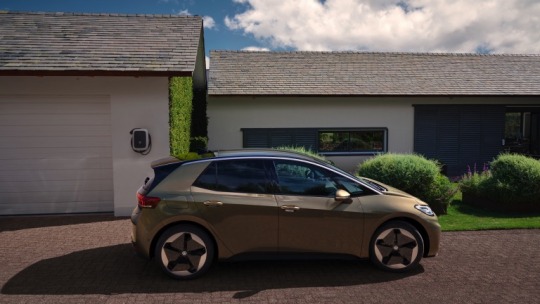
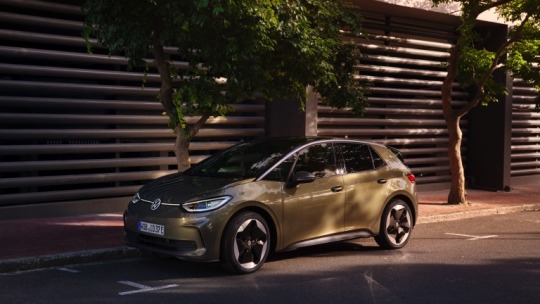
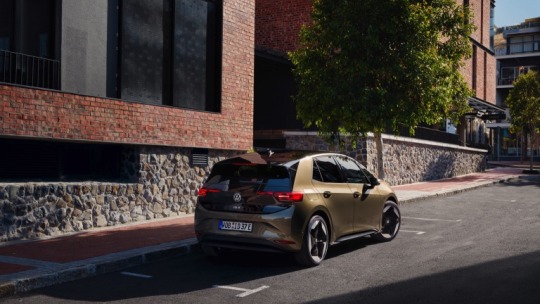
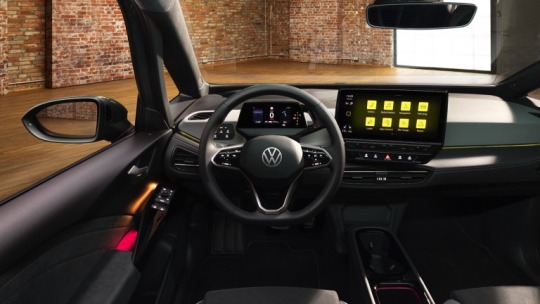

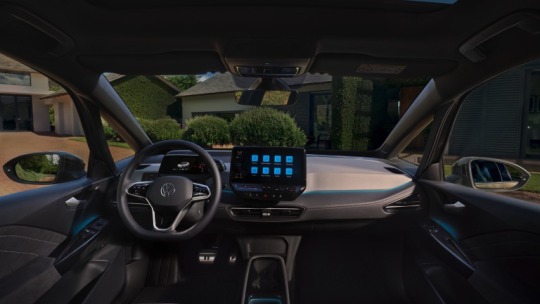
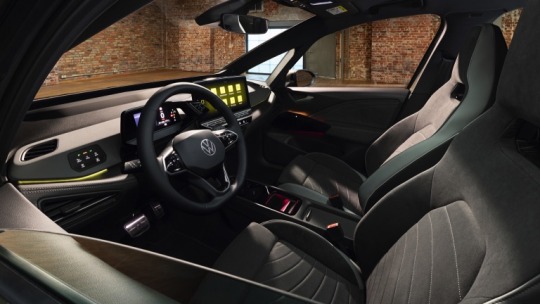
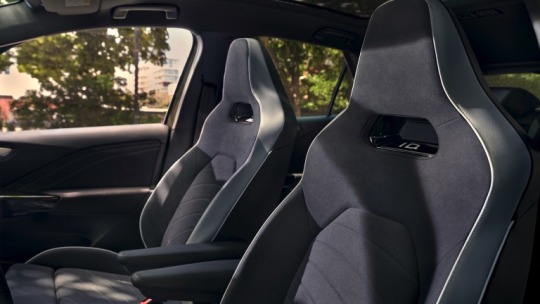
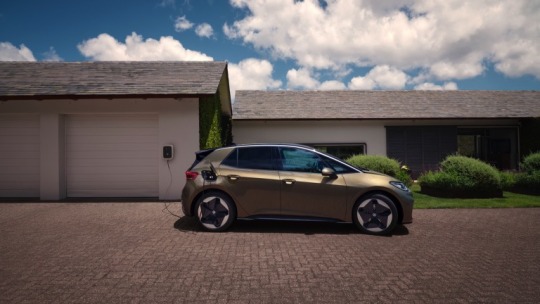
One of the best things about electric cars in 2023 is that we are now seeing 1st generation models from the “early years” being improved, revised and facelifted. For the early-adopters in the UK’s EV market, we are grateful for those consumers and businesses for having the foresight and courage to invest into all-electric technology in 2018 / 2019 / 2020, when little was known on how good this form of transport would be (and when public charging infrastructure was still in its early inception). And VW’s electric Golf replacement, the ID.3, was first shown to the world in 2016 before being pushed into production in 2019 with deliveries taking place around 2020 around Europe (including the UK). As one would expect, the ID3 was fairly popular, amassing some 11,032 registrations in 2021 (it was the 3rd best-selling EV in the UK) followed by becoming the 4th best-selling UK EV with 9,178 registrations in 2022! (see SMMT for more details - https://media.smmt.co.uk/). Launching with a Pure battery (45 kWh), Pro battery (58 kWh) and Pro S configuration (77 kWh), VW’s all-electric hatchback filled a necessary hole in the UK’s automotive market, which was historically dominated by SUVs and luxury / prestige options. Winning awards, like the Which? Best Buy of 2023 (https://www.which.co.uk/reviews/new-and-used-cars/volkswagen-id-3-2020), does prove that this is very much the zero-emission Golf equivalent.
But the “future of driving” is not a completed model and the German group have now confirmed a series of external, integral and technological improvements to this popular EV (see VW - https://www.volkswagen.co.uk/en/electric-and-hybrid/electric-cars/the-new-id3.html). As the “evolution of electric mobility” continues, the brand have confirmed some truly existing updates including:
Exterior - new colours such as Dark Olivine Green, sharper profile at the front together with new tail light clusters and dynamic turn signals plus IQ.Light LED matrix headlights set to be offered. New alloy options including the 19” Wellington and 20” Sanya alloys, a new Exterior Package will allow drivers to add LED matrix headlights with automatic lighting control, LED tail lights, illuminated strip between headlights and tinted rear windows. An Exterior Packages PLUS includes a panoramic roof and sun blind;
Interior - increased options on the dash and door trim, together with higher quality finish. Ability to upgrade to the optional electric seats with massage function and high-quality fabric. New panoramic glass roof with “heavenly views” and sunblind; and
Technology and safety - 8-colour ambient lighting, Travel Assist with adaptive lane guidance and predictive cruise control, Emergency Assist, Area View with 4 cameras, Adaptive Cruise Control, Lane Keeping Assist and Park Assist Plus can all be added to your new ID3.
Not unlike many other brands, the ID.3 will be utilising over-the-air updates for continual improvements coupled with the We Connect ID app for synergising your vehicle to your mobile device. Many EV customers enjoy the facility to start and stop charging, or warm their vehicle, from the comfort of the app.
3 notes
·
View notes
Text
A Grand Tourer with No Wrong Place to Sit
Los Angeles International Airport to London-Heathrow takes 14 hours and 51 minutes, where the layover steals two hours and five minutes more. London-Heathrow to Nice Côte d’Azur necessitates another two hours and 55 minutes. Passport control in Nice takes an hour and 32 minutes. So, that’s 19 hours and 18 minutes spent breathing recycled air among the malignant masses. Facing another 45-minute car ride at the end of all that would be enough to put anyone in a state of utter exhaustion, but through the airport’s exit sits the 2020 Bentley Flying Spur, silently idling. Slump into the calfskin rear seats with intent, massage function at full shiatsu, and you can’t help but melt into the porcelain-smooth hide. Gliding away from a stop, the fatigue lifts like the morning fog, and it’s crystal clear that Bentley’s finally made the Flying Spur worthy of the “Flying B.”
The 2020 Bentley Flying Spur, By the Numbers
- Base Price (As Tested): $214,600 ($261,340) - Powertrain: Twin-turbocharged 6.0-liter W-12 | 8-speed dual-clutch automatic | all-wheel drive - Horsepower: 626 horsepower @ 6,000 rpm - Torque: 664 pound-feet of torque @ 1,350-4,500 rpm - 0-60 MPH: 3.7-seconds - Top Speed: 207 mph - Curb Weight: 5,373 pounds - Quick Take: Whereas the last-generation Flying Spur lacked the opulence to take on Rolls-Royce, Bentley’s new grand tourer is a depleted uranium round aimed at Goodwood. Richard Pardon
Accouterments Fit for the Prince of Monaco
While prior Flying Spur generations felt rich enough, subtle reminders of the car’s provenance in the Volkswagen empire seeped through the quilted leather, brushed aluminum, and warm-toned wood. You’d find an indicator stalk from a Golf, an out-of-date infotainment system, some dreadfully common plastics, and a number of other shined-up pieces from the VW parts bin. And you just knew Bentley could rival Rolls-Royce in exclusivity if given the funds. The funds have finally been delivered. Speaking to The Drive, Bentley’s Head of Interior Design Darren Day said the design brief for the Flying Spur was “Future Luxury,” meant to maintain its lavishness for decades beyond a modern car’s traditional lifecycle. Anchoring that ambition, and in a callback to historics like the original 1952 Flying Spur, wood and metal are the main ingredients in the 2020 model. Employed throughout, the materials come through in knurled aluminum bezels; weighted, hand-carved wooden buttons; and the brightwork around the analog dashboard clock. There’s forceful resistance behind each knob, dial, and switch, so much so that you half-expect to hear a camera’s shutter with every push. Other touchpoints in the 2020 Flying Spur feel truly worthy of the Bentley marque, padded and polished six ways from Sunday. Bentley Bentley Bentley Bentley Bentley’s Rotating Display, seen in the new Continentals, furthers the timeless goal by literally flipping the center of the dashboard between a 12.3-inch HD display, a trio of analog dials (time, outside temperature, and compass), or a full-length, blank wood veneer panel that’s sure to satisfy your inner minimalist. And like a teaspoon twirling around a teacup’s enamel rim, the Flying Spur’s seats pull you into the Sunken Place—but you know, less maliciously. Up front, multi-way adjustability allows for Saville Row fitment for either driver or passenger. Heated, cooled, and adaptive bolsters keep each person stable and at the perfect temperature. Multi-function massage programs come standard and will leave you tempted to drop a $30 tip in the cupholder. Fittingly, things are even better in the back. If they’re not blissed out in those opulent recliners, rear passengers have access to the Flying Spur’s systems via a seat-mounted screen or a removable remote control integrated into the rear-seat center console. Popped out, you can close the rear blinds, sun-roof, and change the HVAC system. You can also input destinations and adjust the car’s media. A champagne fridge is still available. Praise be. Bentley
Classic Looks, New Hotness Firepower
Yachts, Rolexes, Michaelangelo’s David, gold bullion; there’s a luxury to heft. Bentley calls the Flying Spur’s tonnage “Prestige Mass,” which is a nicer way to announce the Flying Spur tips the scales at 5,373-pounds—and that’s with an all-new aluminum chassis and aluminum body. Weight aside, there’s no mistaking the 2020 car as anything but a true full-size luxury automobile. The wide aluminum grille, redesigned “Flying B” emblem, limo-like 125.75-inch wheelbase, and planted stance deliver equal parts power, presence, and the exclusive feel Bentley customers demand. But by far the most noticeable design improvement has to be the 2020 Bentley Flying Spur’s obsidian-sharp crease lines along the body. Bentley credits these expensive-looking ridges to its new “Superforming” aluminum shaping process, which heats the metal to over 500℃ and then presses it into a mold. Panels are then laser-cut to shape and affixed to the extruded aluminum chassis. Once the car comes together, customers can choose from 17 standard Bentley colors. One-off hues can be ordered through Bentley’s Mulliner division—along with different styles of brightwork, trim, and personalization options to deliver a truly one-of-one creation. Bentley Bentley Bentley Bentley Bentley But ask any would-be mafia boss: Presence only gets you so far. In the end, you need the knuckledusters to back up the flex. Powered by a 6.0-liter twin-turbocharged W-12 engine, the Flying Spur warps the world outside its isolated interior with 626 horsepower and 664 pound-feet of torque. While the last car used a fixed Haldex-style all-wheel drive system with a specific torque split, the new Flying Spur is capable of divvying it up on demand, running primarily in rear-wheel mode and sending various amounts of power to the front depending on circumstances and the selected drive mode. Zero to 60 mph happens in just 3.7 seconds, 100 mph in 8.2, and the Flying Spur will soar all the way up to a top speed of 207 mph—unquestionable supercar territory. Bentley’s ZF-sourced 8-speed dual-clutch transmission, all-wheel steering, torque-vectoring, and adaptive suspension all blur the line between sports car and grand tourer. So has Bentley produced a brogue shoe with Air Jordan moves? As proven on a test route including part of the famed Monte Carlo Rally course, the answer is yes. Bentley
The Aristocracy Attacks
Imagine forcing a Corgi through a Pringle’s can, but if the Corgi touches the can’s walls, it dies. Initially, that’s the impossible care with which you’ll approach the task of driving the massive 2020 Flying Spur on European B-roads, let along the Monte Carlo course. These capillaries are built for cars magnitudes smaller, not a rolling panic room that’s 209 inches long and over seven feet wide (including the mirrors). But the big Bentley has two key size-defying tricks that make it far more adept at devouring twisted tarmac than you’d initially expect. One is the adaptive suspension with three-chamber airbags that tighten up nicely on command; that system is augmented by the 48-volt adaptive anti-roll bars that further flatten the body through curves. The other is a new all-wheel steering setup, mechanically reducing the wheelbase by turning the rear wheels in the opposite direction during lower-speed maneuvering and in parallel on the highway. Combined, these advancements trick the Bentley Flying Spur into acting like an Australian V8 Supercar with seamless ease. Put it Sport Mode on a road like the Monte Carlo course—a precariously narrow thing carved into the mountains of the Parc Naturel Régional des Préalpes d’Azur and lined with unforgiving stone—and it’ll outperform sports cars half its size. Some care must be taken when you don’t own the quarter-million-dollar vehicle at hand, of course, but its sheer competence and balance makes it impossible to resist apex hunting. Throw an uptempo track on that 19-speaker Naim sound system and you’ll feel a magnetic pull between the throttle and the lambswool carpet. Go ahead, the Flying Spur can take it. The boosted 6.0-liter W-12 and 8-speed dual-clutch don’t fire with the railgun intensity of a twin-turbo AMG V8; instead, it works with unflinching intention and force. Bentley When not reenacting the Italian Job, this leather-lined cruise missile comes off Defcon 1 to offer traditional Bentley decorum. Comfort Mode slackens the steering bite while the adaptive suspension maps the road ahead to pre-cancel any imperfection. The ride is sublime, though the Flying Spur’s heft returns as it sways to and fro like a yacht in Monaco’s harbor. Still, the world slows and you’re free to enjoy the pristine countryside, your company (or solitude), or some light classical music through the Naim stereo. Hours can tick by like seconds. Though chasing superminis across France is good fun, this is where driver, passenger, and car are happiest. It’s worth noting that the Flying Spur doesn’t have a wrong place to sit; great as it is to drive, its rear seats still beckon. Newly opulent in a way the previous generation just couldn’t muster, they’re massaged, heated thrones that you can tilt to what seems like impossible angles given the exterior dimensions. It’s not quite a Business Class lay-flat seat, but it’s getting close.
Rolls-Royce, Mercedes-Benz, You’re Both On Notice
Bentley once had a period where “Good Enough” prevailed with a line of ultimately forgettable cars. Beginning with the Bentayga and new Continental GT, and now the new 2020 Flying Spur, that’s no longer the case. There’s just this meticulous attention to detail heretofore unseen in new Bentleys, and no question whether it’s worth the steep cost of admission. Though the Bentley Flying Spur’s $214,600 starting price is heart-attack inducing for mere mortals���with a spendy options list longer than War and Peace—it lines up favorably next to a Mercedes-Maybach S 650 ($199,900), a Rolls-Royce Ghost ($311,900), or a loaded-out Porsche Panamera Executive Turbo ($163,400, but with a similarly-ambitious options ladder). Where it beats all those is in the perfect balance of prestige, power, presence, and capability. This is a holistic car. This is a car of occasion. This is a car that makes literally every trip better; it will never see you second-guessing the purchase. Crewe came to chew champagne bubblegum and take names and it’s all out of champagne bubblegum. The Flying Spur is the new superluxury yardstick. Got a tip? Want to talk? Email the author at [email protected] or find him on Twitter @jonathon_klein. Car Buying Service Source link Read the full article
0 notes
Photo
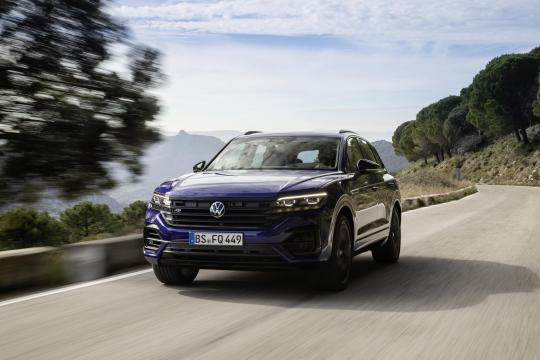



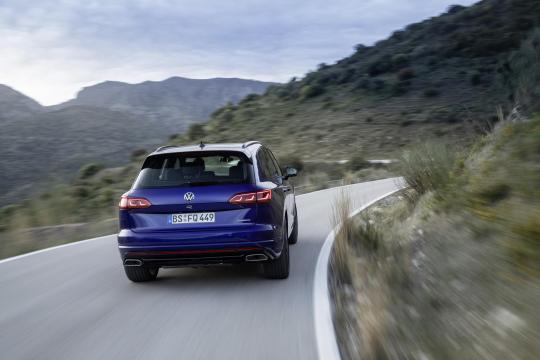
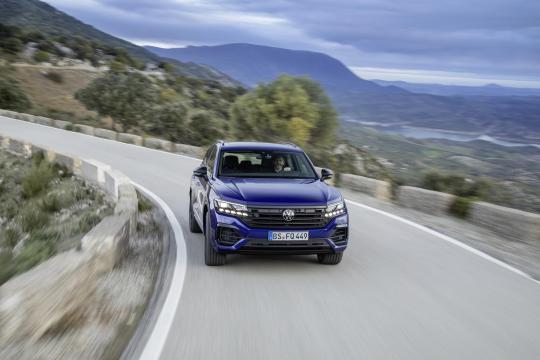
First Look: The Volkswagen Touareg R - Plug-in Hybrid
Volkswagen is set to add a range-topping new premium model to its flagship Touareg line – the Touareg R. The versatile model’s 340 kW (462 PS) plug-in hybrid drive offers an innovative blend of superlative performance and electric efficiency. When the battery is sufficiently charged, the new SUV always starts in the all-electric E-MODE for zero emissions. The battery capacity is designed so that the Touareg R can cover the average daily commute under electric power. Like all Touareg models, the new R version comes with permanent all-wheel drive (4MOTION) as standard. 4MOTION and the powerful drive system (700 Nm of torque) means the Touareg R has also been homologated for a maximum trailer weight of 3.5 tonnes. The premium model can cope with this maxi- mum trailer weight even in E-MODE. As the first plug-in hybrid SUV in the world, the Touareg can also be fitted with the trailer maneuvering system Trailer Assist. And yet another first: the Touareg will be available with Travel Assist for the first time. The premium model will be the first Volkswagen to boast assisted driving (automatic longitudinal and lateral guidance) up to a speed of 250 km/h.
First R model with plug-in hybrid. The new flagship model was designed by the Volkswagen R performance brand, which traditionally develops the sportiest models in the Volkswagen range. The Touareg R represents a paradigm shift – it is the first Volkswagen R model to feature a plug-in hybrid drive. It is also the first time a hybrid model has been the most highly-powered Volkswagen. The extremely well appointed Touareg R, which features the Black Style exterior design package along with 20-inch alloy wheels & R-Line interior trim (including Vienna leather), is set to enter the market in the second half of 2020.
Intelligent electric performance. The Touareg R is the third plug-in hybrid model in Volkswagen’s European product line, following in the wheel-tracks of the Golf and Passat. The Touareg R is the first all-wheel drive model in Volkswagen’s PHEV range, and is also another milestone in the realignment of Volkswagen R that started in 2019. Jost Capito, managing director of the Group’s in-house performance brand, explains: “We are currently vigorously expanding the Volkswagen R range. Following the compact CUV models – T-Roc R1and T-Roc Cabriolet R-Line2 – Volkswagen R is introducing another sport utility vehicle within a very short space of time – the Touareg R, which has a quite unique position and unrivaled charisma.” The Touareg R is synonymous with a new and intelligent level of electric performance in segment of large touring SUVs.
Authentic, avant-garde, practical. Volkswagen R is responsible for the visual and technical configuration, and with it the conceptual direction of the new model. The Touareg R is based on the third generation of the product line launched in 2018, which in turn was an evolution of the model first introduced in 2002. All current Touareg models feature a dynamic and elegant design, maximum safety and long-distance comfort, state-of-the-art connectivity and a largely digitized cockpit. The overall concept is also designed with a high level of everyday usability in mind. Some 60% of all Touareg owners in Germany and 40% in Europe also use their SUV as a towing vehicle – remarkably high figures. The Touareg is often driven by sporty, active people who value the utmost safety, outstanding driving comfort, intuitive control and cutting-edge connectivity. The new Touareg R has been designed specifically for this extremely tech-savvy customer group. For the first time, they now have a performance model that can be driven temporarily in all-electric mode with zero local emissions. The new Touareg com- plies with the Euro 6d-TEMP-EVAP-ISC emission standard.
Extended powertrain range. The SUV product line is currently available with one turbocharged petrol engine (TSI) and three turbocharged diesel engines (TDI). The V6 TSI engine delivers a power output of 250 kW (340 PS)3. As a V6 TDI, the Touareg is available with two output levels: 170 kW (231 PS)4 and 210 kW (286 PS)5. The current most powerful Touareg is a V8 TDI with 310 kW (421 PS)6. Volkswagen is adding a range-topping model in the form of the new Touareg R.
Top R dynamic performance. As a typical Volkswagen R model, the Touareg R provides ultra-dynamic performance. Like at the touch of a button, the driver just has to press the accelerator to access the full output of the electric motor (100 kW/136 PS) and the turbocharged V6 petrol engine (250 kW/340 PS) as required. The two drive systems can then be combined in a boost function to use the vehicle’s dynamic reserves – for instance to over- take another vehicle quickly and safely – and to exploit the full system power of 340 kW (462 PS). The maximum system torque is 700 Nm.
All-wheel drive hybrid. The hybrid drive of the Touareg R essentially consists of a 2,995 cm3 V6 turbocharged petrol engine, the electric drive motor and a lithium-ion battery (energy capacity of 14.1 kWh) built into the luggage compartment underbody. The power electronics convert the direct current of the battery into alternating current for the electric drive motor. An 8- speed automatic gearbox (with Tiptronic) and a transfer box transmit power to the front and rear axles (4MOTION permanent all-wheel drive). A center differential lock with asymmetric dynamic torque distribution (Torsen traction) acts as a transfer box for the flow of forces between the front and rear axle. A maximum of 70% of the drive force reaches the front axle and up to 80% reaches the rear axle.
All-electric drive up to 140 km/h. When first started, the Touareg R uses only the electric motor if the battery is sufficiently charged. This ensures that the SUV comes as close to zero emissions as possible, especially on short journeys. This hybrid strategy also provides the greatest savings potential. The Touareg R can be driven in all-electric mode at a speed of up to 140 km/h; above this, the V6 TSI is activated automatically – or at any time using kickdown. The maximum speed of the SUV is electronically regulated at 250 km/h.
#Volkswagen Touareg R#Volkswagen Touareg#Volkswagen#cars#suv#news#Touareg R#german#hybrids#germany#first look#vw
24 notes
·
View notes
Photo

2020 Volkswagen Golf 8 - interior Exterior and Drive https://ift.tt/2Whw0Ck
4 notes
·
View notes
Text
2020 Volkswagen Golf 8 Redesign, Interior, Price
2020 Volkswagen Golf 8 Redesign, Interior, Price
2020 Volkswagen Golf 8 Redesign, Interior, Price – The precise 2020 Volkswagen Golf 8 Redesignwill be without a doubt far larger together with sportier instead of her forerunner. The specific Volkswagen, nonetheless, ventures it gives them more to have this hatchback far more certified. Even so, anyone 2020 Volkswagen Golf 8 could possibly eliminate the MQB program also alternatively foundation…
View On WordPress
#2020 Volkswagen Golf 1 8 GTI#2020 Volkswagen Golf 2 8 V6 4motion#2020 Volkswagen Golf 8 GTD#2020 Volkswagen Golf 8 GTI#2020 Volkswagen Golf 8 Interior#2020 Volkswagen Golf 8 Price#2020 Volkswagen Golf 8 R#2020 Volkswagen Golf 8 Release Date#2020 Volkswagen Golf 8 TDI#2020 Volkswagen Golf S 80#2020 VW Golf 1 8 TSI#2020 VW Golf 8 Images#2020 VW Golf GTI#Future 2020 Volkswagen Golf 8#New 2020 Volkswagen Golf 8
0 notes
Text
2020 VW GOLF 8 – Design, Interior, Driving
2020 VW GOLF 8 – Design, Interior, Driving
With the new Golf 8, Volkswagen has started a hybrid offensive. As the first model of the brand, the eighth Golf will be available in no less than five hybrid drive versions. Its debut also celebrates 48V technology: a belt starter generator, 48V lithium-ion battery and the latest generation of efficient TSI engines form a new mild hybrid drive in the eTSI. Tangible benefits: consumption has…
View On WordPress
1 note
·
View note
Text
The Audi R8: Origins, Generations, Specifications

All things Audi R8 on Automobile.
Audi R8 Essential History Despite a rich motorsports history with overwhelming success in both rallying and endurance racing, Audi's always remained at arm's length when it came to producing a true sports car. The once-popular Audi TT has most of the right ingredients, but the front-wheel-drive underpinnings pulled primarily from the VW Golf kept it well below the Porsche Boxster, Nissan Z cars, and BMW's assorted roadsters and two-seat coupes.
Since the early 1980s, Audi remained content developing high-performance versions of its premium coupes and sedans, focusing on promoting all-wheel drive technology and turbocharged engines, even if the resulting speed-specials were softer and more road-oriented than the adrenalin-charging weapons from Mercedes-Benz' AMG or BMW's M division.
It was only during the early-2000s when the reality of an Audi supercar began to coalesce, born from Audi's ongoing Le Mans domination and the then-recent acquisition of Lamborghini by the Volkswagen Auto Group. To amortize the cost of development of the nascent Lamborghini Gallardo and to bring Audi a little closer in-line with Mercedes and BMW, the plan for the mid-engine Audi R8—the brand's first supercar—took shape with the Le Mans Quattro concept in 2003.
Audi Le Mans Quattro Concept Visually, the Audi Le Mans Quattro concept was nearly identical to the production R8 that arrived in 2007, though the wild twin-turbo V-10 engine was tossed for a more production-friendly iteration of Audi's naturally aspirated 4.2-liter V-8. Power was reasonable for a mid-engine sports car of the era, with 414 horsepower and 317 lb-ft of torque sent to all-four wheels through either Audi's R-Tronic six-speed automated manual or a gated six-speed manual transmission. Zero-to-60-mph times for these early R8s were around the low four-second mark, with a top speed around 188 mph.
The Audi R8 Goes V-10 For the 2009 model year, the R8's Lamborghini roots shone in full-force, when the updated 5.2-liter V-10 from the Lamborghini LP560-4 was shoehorned into the R8. Fun fact—that Lamborghini V-10 is actually an Audi V-10 pulled from the S6 and S8. So, the R8 V10 actually uses an Audi V-10 pulled from a Lamborghini, but we digress. The V-10 engine increased the R8's output to 518 horsepower and 391 lb-ft of torque, dropping the zero-to-60 mph sprint to 3.9 seconds, and raising top speed to 196 mph.
The Audi R8 Spyder Drop-top Spyder variants launched for both the V-8 and the V-10 models, with the V-8 adding an extra 14 horsepower over the V-8 coupe, growing the total to 428 horsepower, though torque remained unchanged at 317 lb-ft. The limited edition R8 GT arrived in 2011, cutting 220 pounds from the curb weight of the regular R8 V10, while increasing the V-10's output to 552 horsepower and 398 lb-ft of torque. As you'd expect, the R8 GT also brought with it a range of suspension, braking, and aerodynamic upgrades over the regular car to compensate for the additional power and to enlarge the overall performance envelope. Production of the GT was limited to 333 units worldwide, with an additional 333 unit run of the corresponding R8 GT Spyder.
The first-generation R8 received a mid-cycle refresh for 2012 in the rest of the world, arriving in the U.S. in 2013 as a 2014 model year. The refresh brought mostly aesthetic updates, though a few significant mechanical upgrades were also brought to the R8, most significantly a new seven-speed dual-clutch replacing the balky R-Tronic automated manual transmission. Standard magnetic damping was also added for the R8 V10, an optional upgrade for the V-8 models.
The R8 V10 Plus arrived on our shores in 2014, adding a new range-topping trim with extra power and performance in the same vein as the older R8 GT. The same 5.2-liter V-10 as found in the standard R8 V10 was upgraded to 542 horsepower and 398 lb-ft of torque in the R8 V10 Plus, which also got a re-tuned suspension, updated interior, and massaged aesthetics.
Second-Generation Audi R8 After these short-lived upgrades, the first-gen R8 was replaced by an all-new model in 2015 for the 2016 model year. In keeping with the Lamborghini bones of the prior generation, the second-gen R8 shares much of its structural DNA with the Lamborghini Huracan. This includes the familiar 5.2-liter naturally aspirated V-10—the only engine offered at the moment—initially available with either 533 horsepower and 398 lb-ft of torque in the base R8 coupe or 602 horsepower and 413 lb-ft in the R8 V10 Plus coupe. With the exception of the limited-edition R8 RWS (Rear Wheel Series), power is transferred to all-four wheels through a seven-speed dual-clutch transmission.
For 2019, the second-gen R8 was updated with extra power and an aesthetic refresh. Power for the base coupe jumped to 562 horsepower and 413 lb-ft, while the newly renamed R8 Coupe Performance Quattro packs 602 horsepower and 443 lb-ft of torque. Performance for all iterations of the second-gen R8 is impressive; factory-quoted zero-to-60 mph times range between 3.2 seconds and 3.5 seconds, though these times have proven to be conservative in independent tests.
Audi R8 Highlights Time will likely be kind to the Audi R8. The first generation of the supercar consistently ranks at the top of many enthusiast's lists of best designs of the 2000s, and it's only going to get better with time. Although older R8s may carry a bit of a stigma as simply a used supercar, give it time—or pick one up now, while they are at the bottom of their depreciation curve.
Once the first R8s are out of the too-new-to-be-classic but too-old-to-be-cool dead zone, the R8 will be one of the better ways to get into something genuinely exotic for not much more than the price of entry to a loaded mid-size crossover SUV. Early V-8s are particularly inexpensive to purchase, and compared to a Ferrari or Lamborghini of similar vintage, significantly less expensive to keep on the road. As far as upkeep price goes, think more than a BMW or Audi sedan, and less than an Aston Martin—maintenance on a regular Porsche 911 is likely a good comparison.
By design, the R8 of any generation is a more professional, lower-key supercar—if that's even a thing. The current R8 is priced closer to the Porsche 911 Turbo, current Acura NSX, and Aston Martin Vantage than to Lamborghini's Huracán or McLaren's 720s, but in our experience, the R8 doesn't fall far short of those more exotic models in performance or theater. In fact, we'd likely take a new R8 over any of the listed alternatives on the strength of its sound and the vicious launch control. We've also heard whispers that a first-gen Audi R8 V10 with the gated manual transmission is one of the best "exotic" experiences that can be had for less than $100,000, so there's that.
Audi R8 Buying Tips Audi R8s of any generation or spec are fairly robust and shouldn't provide too many undue surprises mechanically. A thick sheaf of maintenance records is always a welcome inclusion with any potential purchase, as is a pre-purchase inspection at a local specialist or dealer. Parts availability for the R8 is high, considering even the oldest R8s still have factory support from Audi—for now. As stated above, expect regular maintenance bills similar to what you'd expect of a Porsche 911.
If you are in the market for a first-gen R8, we highly suggest you seek only those with either the six-speed manual transmission or the later dual-clutch examples. Avoid the R-Tronic at all costs; it's clunky, slow, relatively fragile, and for some enthusiasts, ruins the overall experience. Engine type matters, too, as V-8s will obviously be more affordable than the V-10s, but there is a significant difference in both speed and upkeep between the two engines—as well as a difference in prestige, which can enhance (or detract from) collectibility.
Audi R8 Auctions Despite undeniable desirability, the Audi R8 isn't collectible enough to cross the stage at major auction houses—yet. Bring a Trailer never disappoints, as the healthy record of sold R8s is enough to give an idea of what you might pay for a first generation. For second-generation R8s—the current model—there are enough on Audi lots that you might be better off getting one straight from the source.
This 2009 Audi R8 4.2 w/ six-speed manual and only 8,000 miles sold for $67,000
A 2010 Audi R8 V10 w/ six-speed manual sold for $72,000
This second-gen 2018 Audi R8 RWS claimed $118,000
A late-model first-gen 2015 Audi R8 4.2 with six-speed manual was bought for $80,000
Audi R8 Quick Facts First year of production: 2007 Last year of production: Ongoing Base Price: $171,150 (2020) Audi's first supercar Lamborghini bones for (relatively) cheap Time will be very, very kind to the R8 family We'll take ours with the V-10 and the gated manual, please Audi R8 Articles On Automobile We drove the refreshed first-generation Audi R8 in 2012.
Here's our review of the second-generation Audi R8 V10 Plus.
We sampled the rare Audi R8 RWS as well.
We got our hands on the updated second-gen Audi R8 late last year.
And just for fun, here's a test of the race-ready Audi R8 LMS.
Audi R8 FAQ You have questions about the Audi R8. Automobile has answers. Here are the answers to some of the most frequently asked Audi R8 queries:
Is The Audi R8 A Supercar? Absolutely. With any engine or transmission and from either generation, the Audi R8 is quick, fast, and visually stunning enough to be considered a supercar.
How Fast Does An Audi R8 Go? The early first-gen Audi R8 4.2s topped out at 188 mph, while the latest and greatest Audi R8 V10 Performance Quattro smacks a mighty 206 mph.
How Much Is The New Audi R8? The base 2020 Audi R8 will run you $171,150.
What Year Is The Best Audi R8? Hmm, great question. We reckon it depends on what you want from the car. For an engaging drive, we'd pick the cleanest first-gen V-10 with the gated manual we could find. However, the current R8 is stunningly quick and aurally spectacular as any car we've driven, so perhaps one of the few R8 RWS would find its way into our dream garage. ผลบอล7mคะแนน
Contact us by Line ID: @ufa98v2
#ผลบอล7mคะแนน#ผลบอลสด#บ้านผลบอล#ผลบอล#ผลบอลเมื่อคืน#ผลบอลสดทุกลีก#ทีเด็ดบอลวันนี้#ทีเด็ดบอล#ทีเด็ดฟุตบอล#ทีเด็ดบอลคืนนี้#ทีเด็ดบอลชุด 4 ตัว#แทงบอลออนไลน์#แทงบอล#แทงบอลสเต็ป#แทงบอลสด#สูตรแทงบอล#วิเคราะห์บอล#ราคาบอลไหล#ราคาบอล#ตารางบอลวันนี้#ตารางบอล
0 notes
Photo

TEST DRIVE VW GOLF 8 2020 [VIDEO] Volkswagen Golf 8, aceeași mașină ce pare conservatoare din exterior, dar uimește plăcut la interior Mașina germanilor s-a reinventeze odată cu generația a opta și a devenit mult mai tehnologizată: ecranele LCD au înlocuit tot ce însemna ceas analog, iar … Continue reading → Citeste mai mult pe: Stiri Autovit
0 notes
Photo

TEST DRIVE VW GOLF 8 2020 [VIDEO] Volkswagen Golf 8, aceeași mașină ce pare conservatoare din exterior, dar uimește plăcut la interior Mașina germanilor s-a reinventeze odată cu generația a opta și a devenit mult mai tehnologizată: ecranele LCD au înlocuit tot ce însemna ceas analog, iar … Continue reading → Citeste mai mult pe: Stiri Autovit
0 notes
Photo

TEST DRIVE VW GOLF 8 2020 [VIDEO] Volkswagen Golf 8, aceeași mașină ce pare conservatoare din exterior, dar uimește plăcut la interior Mașina germanilor s-a reinventeze odată cu generația a opta și a devenit mult mai tehnologizată: ecranele LCD au înlocuit tot ce însemna ceas analog, iar … Continue reading → Citeste mai mult pe: Stiri Autovit
0 notes
Photo

TEST DRIVE VW GOLF 8 2020 [VIDEO] Volkswagen Golf 8, aceeași mașină ce pare conservatoare din exterior, dar uimește plăcut la interior Mașina germanilor s-a reinventeze odată cu generația a opta și a devenit mult mai tehnologizată: ecranele LCD au înlocuit tot ce însemna ceas analog, iar … Continue reading → Citeste mai mult pe: Stiri Autovit
0 notes
Text
Voyage 2019: versões, preços, equipamentos, motor, fotos, etc
O Voyage 2019 ganhou uma importante novidade, a transmissão automática, que chegou ao velho sedã da VW depois de quase 40 anos de mercado, onde apenas chegou nem perto de dispor desse recurso.
Com 38 anos, o Voyage só chegou a ter câmbio automatizado ASG na versão I-Motion em meados da década de 2010. Na ocasião, o sedã compacto de entrada recebeu o recurso como uma forma de baratear a automatização da condução.
Agora, algo que muitos pensaram que nunca aconteceria, se concretizou. Adotando o câmbio AQ160 F, o sedã popular simplesmente teve que trazer de volta o motor EA211 1.6 MSI, que chegou a equipa-lo alguns anos antes.
Nesse momento, o Voyage chegou ao ápice da atenção da Volkswagen para com ele, já que chegou a ter versão com bancos em Alcantara, um luxo que nem mesmo o VW Golf teve por aqui.
Assim, com o câmbio automático Tiptronic com tudo o que tem direito, ou seja, modo Sport, paddle shifts e volante multifuncional, o Voyage 2019 poderia ser um carro mais atraente se fosse o mesmo de 2014.
Na última atualização, mesmo com frente remodelada ao estilo da Saveiro, o sedã foi ainda mais simplificado e tudo parecia crer que seu fim não iria demorar. Contudo, a VW vira a mesa e decide botar a caixa automática.
Dessa forma, o EA211 1.6 MSI com 16V retorna com os mesmos números, que no álcool são superiores aos dos Polo e Virtus MSI, entregando até 120 cavalos e 16,8 kgfm.
Para um carro de pouco mais de uma tonelada, o conjunto dá e sobra. E para completar a gama, a manutenção das versões com motores EA211 1.0 MPI com até 84 cavalos e EA111 1.6 8V com até 105 cavalos e seu torque em giro de 2.0…
Com tantos anos de estrada, o Voyage ainda é um carro bastante confiável e com manutenção bem conhecida, tendo um espaço interno apenas adequado, mas um porta-malas com bons 480 litros.
No layout atual, pega parte da Saveiro emprestado, mas sua essência continua a mesma. Vários itens de conforto básico estão presentes, assim como a segurança obrigatória.
Lançada em 2009, a atual geração do VW Voyage é esperada para expirar em 2022, quando chega um crossover fabricado também em Taubaté-SP, para substitui-lo junto com Gol, Fox e up!.
Construído sobre a plataforma PQ24, em uma variação de baixo custo, o popular da Volkswagen tem um projeto consistente, que foi se atualizando com o tempo, mas adotando motor e câmbio em transversal.
Pensado para ser barato, ele ainda herda muitas coisas de custo reduzido, como botões dos vidros traseiros no painel e até mesmo a ausência de espaços suficientes para copos e garrafas no interior.
Voyage 2019 – detalhes
Com linhas bem funcionais, como todo carro alemão, o Voyage 2019 incorporou o estilo frontal da Saveiro, recebendo alterações na estrutura da frente.
Assim como na picape leve, o capô ficou mais alto, a fim de incorporar faróis maiores, sendo estes simples com fundo escuro ou duplos com elementos cromados. Neste último, só faltaram LEDs diurnos para completar.
A grade também ficou mais alta e volumosa, ganhando um friso cromado que se mesclava com o conjunto ótico. Na versão de acesso, não existem esses detalhes.
O para-choque fora revisado com vincos acentuados nas laterais e grade inferior muito maior, tendo ainda faróis de neblina opcionais. As rodas são de aço aro 14 polegadas no MPI, que tem ainda pneus 185/65 R14.
Já na versões com motores 1.6 de 8V ou 16V, sendo este automático, as rodas são de 15 polegadas, com aço ou liga leve, tendo pneus 195/55 R15. Os retrovisores são pretos ou na cor do carro, sendo que neste último, ganha piscas auxiliares.
As colunas B são pretas, mas as maçanetas vêm na cor da carroceria. Atrás, as lanternas do Voyage 2019 possuem desenho pouco harmônico, que ainda utiliza a base do original de 2009. Elas são cortadas pela tampa do bagageiro.
O porta-malas tem uma tampa com a parte superior proeminente, como um defletor, enquanto o para-choque vem com suporte de placa e refletores.
Por dentro, o design do painel do Voyage é bem moderno, revelando a última atualização da Saveiro e seu compartilhamento com os dois irmãos nascidos também nos anos 80.
Os difusores de ar descrevem uma certa fluidez que agrada, apesar do conjunto ser bem simples. Mesmo assim, não há tampa de airbag do passageiro ou saídas de ar circulares baratas.
Além disso, traz opcionalmente um prático suporte de smartphone com fonte de energia USB. O sedã tem também multimídia Composition Touch com tela de 6,5 polegadas e os sistemas Android Auto/CarPlay/MirrorLink.
Já o cluster, que poderia ser como o antigo, recebeu grafismos diferenciados e ficou mais atraente, diferenciando-se dos demais modelos da marca. O ar condicionado é manual e o volante de três raios pode vir com comandos remotos.
Nele, além de controles de mídia e telefonia, traz ainda comandos de computador de bordo, mas faltou piloto automático. A coluna de direção é ajustável apenas em altura e profundidade, além de paddle shifts com câmbio automático.
O câmbio automático tem seletor com modo Sport e opção de trocas manuais, mas seu visual metalizado é bem antigo, do primeiro Tiguan e vem com alavanca de igual acabamento. Um retrocesso de mais de 10 anos.
Com freio de estacionamento manual, o Voyage 2019 vem com vidros elétricos dianteiros nas portas, enquanto o ajuste dos retrovisores fica junto à maçaneta interna, o que não é de todo ruim.
Atrás, os vidros elétricos ficam nas portas, não sendo assim usada a solução do Santana dos anos 80, que centrava tudo no túnel central. O travamento elétrico é feito por meio de chave canivete.
Com alças no teto, tem luz interna e retrovisores com espelhos, além de antena no teto. O sistema de som pode ter quatro alto-falantes e dois tweeters, enquanto a multimídia traz ainda entrada USB e Bluetooth.
O banco traseiro é inteiriço, tendo apoios de cabeça para todos, além de cintos de 3 pontos apenas para quatro passageiros, pois o quinto é subabdominal. Em 2020, o modelo ganhou um de 3 pontos nessa posição, junto com Isofix.
No bagageiro, 480 litros, o suficiente para uma família pequena. O volume pode ser ampliado com o rebatimento do encosto interno.
Voyage 2019 – versões
O VW Voyage 2019 tem uma proposta de entrada e por isso tem apenas uma versão sem identificação, que internamente na Volkswagen chamam de Trendline:
VW Voyage 1.0 MPI
VW Voyage 1.6 MSI
VW Voyage 1.6 MSI AT
Equipamentos
VW Voyage 1.0 MPI – Motor 1.0 com transmissão manual de cinco marchas, mais ar condicionado, direção hidráulica, vidros dianteiros elétricos, retrovisores externos com controle interno, cintos de segurança de 3 pontos e subabdominal para o quinto passageiro, apoios de cabeça para todos, rodas de aço com calotas aro 14 polegadas, pneus 185/65 R14, retrovisor interno dia e noite, banco traseiro rebatível, bancos em tecido, faróis simples com máscara negra, luzes de frenagem de emergência, para-sóis com espelho, airbag duplo, freios ABS com EDB, entre outros.
Opcionais:
Pacote Urban Completo, tendo alarme com comando remoto, sensor de estacionamento traseiro, luzes de leitura dianteiras e traseiras, alças de segurança no teto, chave com comando remoto, coluna de direção com ajuste de altura e profundidade, espelhos retrovisores e maçanetas das portas na cor do veículo, retrovisores elétricos com tilt down e repetidores de direção, faróis de neblina, lanternas traseiras escurecidas, para-sóis iluminados, rodas de liga leve aro 15, pneus 195/55 R15, tampa do porta-malas com abertura elétrica, travamento elétrico das portas e vidros elétricos traseiros.
Pacote Interatividade Media Plus com 4 alto-falantes e 2 tweeters, rádio Media Plus com bluetooth, MP3 e entradas USB, SD e auxiliar.
Pacote Interatividade Composition Touch com computador de bordo, 4 alto-falantes e 2 tweeters, multimídia Composition Touch (Android Auto/CarPlay/MirrorLink) e volante multifuncional.
VW Voyage 1.6 MSI – Motor 1.6 8V com câmbio manual de cinco marchas, mais itens do 1.0 MPI.
Opcionais:
Pacote Interatividade Media Plus
Pacote Interatividade Composition Touch
Pacote Urban Completo
VW Voyage 1.6 MSI Automático – Motor 1.6 16V com transmissão automática de seis marchas com modo Sport e opção de trocas manuais na alavanca ou no volante multifuncional com paddle shifts, mais itens da versão 1.6 MSI manual.
Opcionais:
Pacote Interatividade Media Plus
Pacote Interatividade Composition Touch
Pacote Urban Completo
Preços
Os preços do VW Voyage 2019 são os divulgados em seu lançamento e estavam dentro da faixa de atuação dos sedãs compactos, embora acima de R$ 50 mil:
VW Voyage 1.0 MPI – R$ 52.640
VW Voyage 1.6 MSI – R$ 56.820
VW Voyage 1.6 MSI AT – R$ 59.990
Voyage 2019 – motor
O VW Voyage 2019 tem três motores diferentes à disposição, sendo que dois deles são mais atuais, pertencentes à família EA211, além de um mais antigo, o EA111. Todos eles são fabricados em São Carlos, interior de São Paulo.
Destes, o EA111 1.6 tem quatro cilindros com cabeçote de 8 válvulas, acionado por correia dentada e sem variável de abertura e fechamento.
Este propulsor chama atenção pela característica de oferecer bom torque em rotação baixa, garantindo boas saídas e um consumo adequado no meio urbano.
Dotado de injeção eletrônica multiponto com tecnologia flex de pré-aquecimento do combustível em partidas a frio, o EA111 tem taxa de compressão 12,1:1, tendo um volume de 1.598 cm3.
Com isso, o vetusto motor da VW alcança 105 cavalos no álcool a 5.250 rpm, tendo ainda 15,6 kgfm a 2.500 rpm. Isso mostra como ele tem disposição em baixa rotação.
O mesmo ainda dispõe, quando abastecido com gasolina, de 101 cavalos a 5.250 rpm e 15,4 kgfm com os mesmos bons 2.500 rpm. Robusto e confiável, o EA111 surgiu no final dos anos 90 no Brasil, substituindo o antigo EA827.
Usado somente nos modelos Gol, Voyage, Fox e Saveiro atualmente, o EA111 está com os dias contados, visto que já tem uma arquitetura antiga, já revisada quando foi chamado de “VHT”.
Nele, apenas o câmbio manual MQ200, que é fabricado pela VW na Argentina. O VW Voyage 2019 ainda dispõe dos modernos EA211.
Assim como o EA111, o mais recente tem construção toda em alumínio, sendo que o MPI é a versão 1.0 com bloco de três cilindros e cabeçote com duplo comando de válvulas, acionados por correia dentada.
Esse pequenino motor tem 999 cm3 e taxa de compressão menor: 11,5:1. Tendo como característica um bom torque em baixa rotação, o 1.0 MPI surge como uma opção bem econômica para quem deseja rodar por mais tempo.
Tendo 4 válvulas por cilindro, o 1.0 MPI vem com injeção multiponto e tecnologia E-Flex de partida a frio por pré-aquecimento do combustível, geralmente álcool.
Com 75 cavalos na gasolina e 84 cavalos no etanol, este pequenino obtém esses números com 6.250 rpm e 3.000 rpm, respectivamente. É o segundo motor do trio com maior sensação de força em baixa.
Lançado no up!, o 1.0 MPI hoje está presente também no Gol e no Polo, mas já foi usado pelo Fox. O outro membro da família EA211 é o 1.6 16V MSI.
Este propulsor de quatro cilindros e cabeçote com 16V, agrupadas sob dois comandos de válvulas, já esteve a bordo do Voyage há alguns anos, mas retorna apenas com a transmissão automática AQ160 F.
Tendo os mesmos 1.598 cm3 do EA111 e a mesma taxa de compressão de 11,5:1 do 1.0 MPI, o 1.6 16V MSI é o propulsor aspirado mais potente da VW, tendo 120 cavalos e 16,8 kgfm com etanol, conseguidos aos 5.750 rpm e 4.000 rpm.
Embora ainda seja baixo o torque, ele se iguala ao antiga EA827 2.0 8V que tinha os mesmos 120 cavalos no álcool, mas seu torque superava 18 kgfm… Também diferente deste, obtém sua força em rotação alta por ser um 16V.
Na gasolina, no entanto, o 1.6 16V MSI é bem mais fraco, tendo 110 cavalos e 15,8 kgfm, conseguidos nas mesmas rotações. Com isso, ele é apenas um pouco mais forte que o EA111 1.6 8V MSI.
Sua estreia se deu há alguns anos e equipou (e ainda equipa) vários modelos, como Golf, Fox, Saveiro, Gol, Polo, Virtus e SpaceFox.
No VW Voyage 2019, ele vem com o câmbio Tiptronic de seis marchas, que tem conversor de torque, além de modo Sport e mudanças manuais na alavanca e volante.
É a caixa automática padrão dos carros nacionais e alguns importados da Volkswagen, como Gol, T-Cross, Virtus, Polo, Nivus e Jetta.
Desempenho
Em desempenho, o VW Voyage 2019 fica devendo na versão 1.0 MPI por motivos óbvios, mas ainda assim não faz de todo ruim. Com o 1.6 8V MSI, o sedã compacto popular tem seu segundo melhor resultado.
Contrariando a lógica das transmissões, o Voyage com motor 1.6 16V MSI é o mais esperto, pois, além de mais potente, também tem um câmbio com seis marchas, que aproveita melhor a força do propulsor.
VW Voyage 1.0 MT – 13,2 segundos e 173 km/h
VW Voyage 1.6 MT – 10,5 segundos e 186 km/h
VW Voyage 1.6 AT – 10,1 segundos e 185 km/h
Consumo
O consumo do VW Voyage 2019 pode ser considerado bom, especialmente no 1.0 MPI, que faz médias excelentes com gasolina, sendo o mesmo repetido pelas outras duas versões 1.6, sendo a mais potente com consumo melhor.
Isso se dá por causa do alto torque em baixa desses motores, mesmo o 1.6 16V, que não é tão esperto quanto os outros dois, mas com o câmbio automático, consegue trabalhar melhor e beber menos.
VW Voyage 1.0 MT – 8,9/10,6 km/l e 13,4/15,6 km/l
VW Voyage 1.6 MT – 8,0/9,9 km/l e 11,6/14,1 km/l
VW Voyage 1.6 AT – 8,0/10,1 km/l e 11,1/14,3 km/l
Voyage 2019 – manutenção e revisão
As revisões do VW Voyage 2019 ocorrem a cada 10.000 km ou 6 meses, sendo que os preços abaixo são atualizados com base em junho de 2020.
O plano de revisão da VW agora contempla valores fixos em toda a rede de concessionários, sendo uma disposição que vem sendo aplicada desde a chegada do Polo.
Embora não tenha grandes diferenças, os motores do Voyage possuem custos de manutenção diferenciados, com valores que tornam o gasto total com as revisões entre R$ 2,8 mil e R$ 3,5 mil, por exemplo.
Então, dependendo da opção motriz, os preços serão mais ou menos salgados. Ainda que variáveis, a faixa de preços até 60.000 km está na média do mercado.
Revisão 10.000 km 20.000 km 30.000 km 40.000 km 50.000 km 60.000 km Total 1.0 12V R$ 253,94 R$ 557,24 R$ 484,94 R$ 716,74 R$ 484,94 R$ 557,24 R$ 2.801,10 1.6 8V R$ 239,79 R$ 607,09 R$ 534,79 R$ 751,29 R$ 534,79 R$ 607,09 R$ 3.274,84 1.6 16V R$ 318,50 R$ 621,80 R$ 549,50 R$ 842,50 R$ 549,50 R$ 621,80 R$ 3.503,60
Voyage 2019 – ficha técnica
Com 4,21 m de comprimento e 2,47 m de entre-eixos, o VW Voyage 2019 é um sedã compacto da gama de entrada, tendo um bom porta-malas de 480 litros, além de um tanque de 55 litros que garante ótima autonomia.
Sem muito espaço interno, o Voyage ainda é uma opção para quem quer um sedã barato, tendo suspensão dianteira McPherson e traseira com eixo de torção.
Motor 1.0 12V 1.6 8V 1.6 16V Tipo Número de cilindros 3 em linha 4 em linha 4 em linha Cilindrada em cm3 999 1598 1598 Válvulas 12 8 16 Taxa de compressão 11,5:1 12,1:1 11,5:1 Injeção eletrônica Indireta Flex Indireta Flex Indireta Flex Potência máxima 75/84 cv a 6.250 rpm (gasolina/etanol) 101/105 cv a 5.250 rpm (gasolina/etanol) 110/120 cv a 5.750 rpm (gasolina/etanol) Torque máximo 9,7/10,4 kgfm a 3.000 rpm (gasolina/etanol) 15,4/15,6 kgfm a 2.500 rpm (gasolina/etanol) 15,8/16,8 kgfm a 4.000 rpm (gasolina/etanol) Transmissão Tipo Manual de 5 marchas Manual de 5 marchas Automática de 6 marchas Tração Tipo Dianteira Dianteira Dianteira Direção Tipo Elétrica Elétrica Elétrica Freios Tipo Discos dianteiros e tambores traseiros Discos dianteiros e tambores traseiros Discos dianteiros e tambores traseiros Suspensão Dianteira McPherson McPherson McPherson Traseira Eixo de torção Eixo de torção Eixo de torção Rodas e Pneus Rodas Aço, aro 14 polegadas Aço ou Liga leve, aro 15 polegadas Aço ou Liga leve, aro 15 polegadas Pneus 185/65 R14 195/55 R15 195/55 R15 Dimensões Comprimento (mm) 4.213 4.213 4.213 Largura (mm) 1.656 1.656 1.656 Altura (mm) 1.464 1.464 1.464 Entre eixos (mm) 2.467 2.467 2.467 Capacidades Porta-malas (L) 480 480 480 Tanque de combustível (L) 55 55 55 Carga (Kg) 439 447 462 Peso em ordem de marcha (Kg) 1.015 1.033 1.058 Coeficiente aerodinâmico (cx) ND ND ND
Voyage 2019 – fotos


















youtube
© Noticias Automotivas. A notícia Voyage 2019: versões, preços, equipamentos, motor, fotos, etc é um conteúdo original do site Notícias Automotivas.
Voyage 2019: versões, preços, equipamentos, motor, fotos, etc publicado primeiro em https://www.noticiasautomotivas.com.br
0 notes
Text
2020 Volkswagen Golf 8 Interior, Release Date, Images
2020 Volkswagen Golf 8 Interior, Release Date, Images
2020 Volkswagen Golf 8 Interior, Release Date, Images – This particular 2020 Volkswagen Golf 8order likely be without a doubt a lot more considerable together with sportier instead of her forerunner. The specific Volkswagen, nonetheless, projects it offers the higher to acquire this hatchback far more skilled. However, anyone 2020 Volkswagen Golf 8 might possibly remove the MQB prepare…
View On WordPress
#2020 Volkswagen Golf 1 8 GTI#2020 Volkswagen Golf 2 8 V6 4motion#2020 Volkswagen Golf 8 GTD#2020 Volkswagen Golf 8 GTI#2020 Volkswagen Golf 8 Interior#2020 Volkswagen Golf 8 Price#2020 Volkswagen Golf 8 R#2020 Volkswagen Golf 8 Release Date#2020 Volkswagen Golf 8 TDI#2020 Volkswagen Golf S 80#2020 VW Golf 1 8 TSI#2020 VW Golf 8 Images#2020 VW Golf GTI#Future 2020 Volkswagen Golf 8#New 2020 Volkswagen Golf 8
0 notes
Text
De SUV compacto a hot hatch, grandes lançamentos virão em 2020
O ano de 2019 foi muito bom para a indústria automobilística brasileira, mas poderia ter sido melhor. O mês de dezembro, por exemplo, alcançou a melhor média diária de vendas em seis anos, com 13.173 unidades. Isso ajudou a baixar o estoque total nas fábricas e concessionárias de 38 dias em novembro para 33 dias em dezembro, ligeiramente abaixo da média considerada normal de 35 dias. No entanto, as previsões iniciais para 2019 eram de crescimento entre 11 e 12% e acabou fechando em 8,6%.
As 2.787.850 unidades de veículos leves e pesados vendidas em 2019 foram suficientes para o Brasil subir de oitavo para sexto lugar entre os mercados mundiais. Porém ainda distante dos 3,8 milhões de 2012, quando o País foi o quarto maior do mundo. Produção total foi prejudicada pela queda das exportações, basicamente em razão da Argentina. Crescimento foi de apenas 2,3% sobre 2018 para 2,94 milhões de veículos.

Não houve mudanças na posição das 10 principais marcas. Chevrolet (18%), VW (16,3%), Fiat (13,4%), Renault (9,5%), Toyota (8,5%), Ford (7,6%), Hyundai (7,5%), Jeep (4,6%), Honda (4,5%) e Nissan (3,9%). Os SUVs desbancaram pela primeira vez os sedãs na preferência dos compradores, ficando apenas atrás dos hatches. Os motores de 1 litro, graças às versões com turbocompressor, subiram sua participação para 39%, a maior dos últimos oito anos.
Confira o ranking completo dos veículos mais vendidos de 2019
O que esperar de 2020? Tradicionalmente, Fenabrave e Anfavea fazem suas previsões logo no começo de janeiro. Ambas confiam no crescimento da economia duas vezes maior, inflação controlada, oferta de crédito em ascensão, financiamentos com juros menores, consumidor mais confiante e nível de emprego em leve recuperação.
Em geral, a entidade das concessionárias é mais conservadora nas projeções, porém para este ano estimou aumento nas vendas de automóveis e veículos comerciais leves e pesados de 9,6%. A Anfavea espera números fracionalmente menores com o mercado interno 9,4% maior que 2019 e 3,050 milhões de unidades vendidas.
O ano de 2020 também terá muitas novidades, o que ajuda a aquecer o mercado e animar o consumidor a ir às compras. Será um período de grandes lançamentos e renovações em maior ou menor escala. Haverá produtos inteiramente novos, mudanças de geração de modelos existentes, versões inéditas de carros já no mercado e atualizações de ano-modelo.

Teaser do SUV compacto Volkswagen Nivus
No primeiro grupo enquadram-se SUV compacto com linhas de cupê VW Nivus, SUVs médios Ford Territory e Escape, sedã compacto Kia Rio, picape média Jeep Gladiator, SUV médio Chevrolet (ainda sem nome), SUV crossover Citroën C5 Aircross, Porsche Taycan, SUV clássico Land Rover Defender e da Chery SUV de sete lugares Tiggo 8, sedã médio Arrizo 6 e SUV de luxo Exeed.
Mudanças de gerações também serão numerosas como hatch compacto Peugeot 208, SUV compacto Chevrolet Tracker, Honda Fit, sedã compacto Nissan Versa, picape compacta Fiat Strada e SUVs compactos Audi Q3 e Mercedes-Benz GLA.
Entre as versões inéditas estarão Polo e Virtus GTS, Onix hatch RS e picape média Amarok de 258 cv. Das atualizações de ano-modelo destaques para SUV compacto Renault Duster e talvez o subcompacto Kwid, picape média Chevrolet S10 e SUV médio-grande Trailblazer.
Alta Roda
PICAPES pesadas, até agora, dependiam de oferta superlimitada e restrita à marca Ram, da FCA. Mas, o grupo ítalo-americano vai importar no segundo semestre a nova 1500, bem maior que as picapes médias atuais (em média meio metro mais comprida). Rivais diretas Ford F-150 (esta já em pré-venda na Argentina) e Chevrolet Silverado também poderão chegar ao Brasil.
VANTAGEM da Ram 1500 é que não exigirá Carteira Nacional de Habilitação (CNH) de profissional, além do preço um pouco menor. No caso da Ram 2500, antes importada a conta-gotas, sempre se tornou um limitador de vendas seu peso bruto total de 4.500 kg. Isso obriga a portar a mesma CNH de motorista de caminhão, que poucos estão dispostos a obter.
PEUGEOT 2008 turbo, com câmbio automático de seis marchas, destaca-se por acelerações bem rápidas e o prazer proporcionado pelo volante de menor diâmetro entre os SUVs compactos. Interior bem acabado e iluminado por teto solar panorâmico também agradam, além de numerosos itens de série e seis airbags. Espaço no banco traseiro é o seu ponto fraco.
VOLKSWAGEN implanta agora no mercado europeu, a partir do novo Golf de oitava geração, plano de manutenção com intervalos estendidos de 12 para 24 meses. Progressivamente será aplicado ao resto da linha. Limites de quilometragem percorrida continuarão sendo considerados, para quem roda acima da média. Boa economia de custos, além de conveniência.
MAIS um golpe de frentistas de postos. Quando pedem para verificar nível do óleo, aproveitam para abrir a tampa do vaso expansor do sistema de arrefecimento. Isso leva a uma leitura errada do nível do fluido (água destilada e etilenoglicol) e aproveitam para vender “reposição” por até R$ 100. Para checar o nível, não precisa abrir a tampa. Reclame e não volte a este posto.
Acompanhe o AutoPapo também no Youtube
O post De SUV compacto a hot hatch, grandes lançamentos virão em 2020 apareceu primeiro em AutoPapo.
https://autopapo.com.br/noticia/lancamentos-2020-suv-compacto/ encontrado originalmente em https://autopapo.com.br
0 notes
Photo

2020 Volkswagen GOLF 8 | Driving, Interior, Exterior | via /r/Autos
0 notes
Link
The Golf is the best European vehicle for over four decades. Another part throughout the entire existence of this smash hit starts today, 24 October 2019, with the world debut of the eighth Golf – digitalised, associated, and natural to work.
0 notes